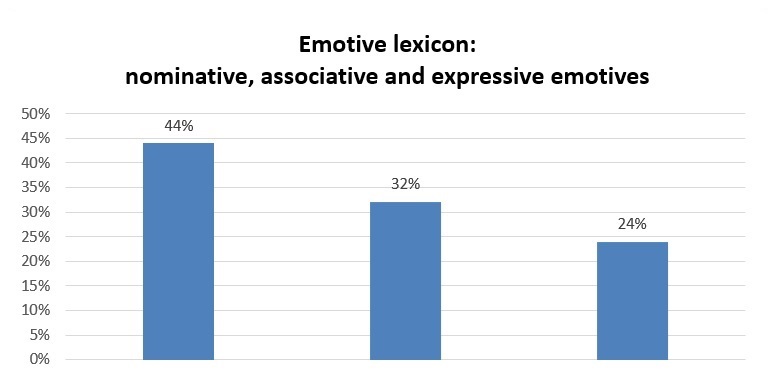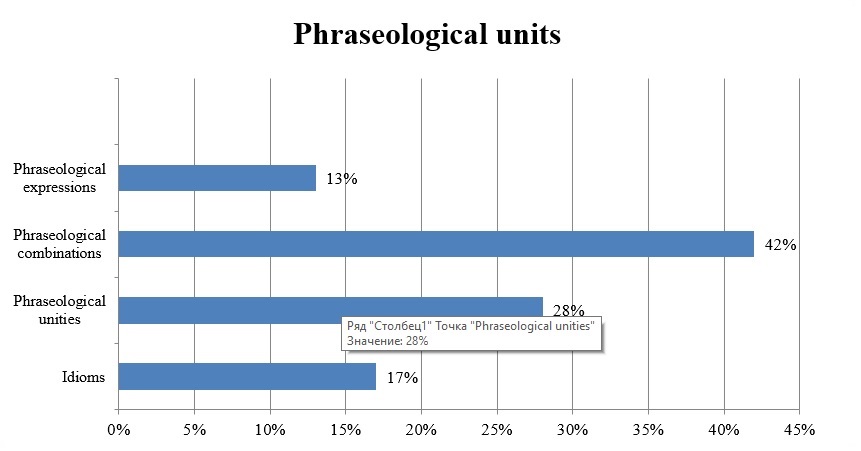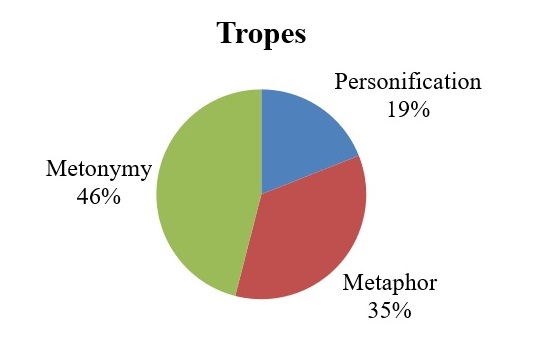NEGATIVE EVALUATION IN THE DISCOURSE OF ENGLISH SPORT REPORTING: LEXICAL AND STYLISTIC MEANS OF EXPRESSION
NEGATIVE EVALUATION IN THE DISCOURSE OF ENGLISH SPORT REPORTING: LEXICAL AND STYLISTIC MEANS OF EXPRESSION
Abstract
The research is focused on the study of expression means of negative (pejorative) evaluation in sports discourse. Based on the textual and audio-video resources related to sports reporting, the authors study lexical and stylistic levels of assessment, their linguistic and pragmatic peculiarities and nuances. The study highlights the broadness of expressive means in the English sports discourse, which is conditioned by their multiple functionalities. The article provides the diagrams presenting the occurrence and frequency of lexical units (emotive lexicon in sports reports; phraseological units and tropes intended to express negative evaluation in a sports report). The research results and findings contribute to the development of sports discourse as the object of linguistic study.
1. Introduction
Sports competitions, their coverage in the press, on radio, television and on the Internet, as well as related medical, mass media, business, financial and even political issues justify the relevance of sports discourse, the study of its linguistic, emotional and cultural peculiarities. Sports discourse exists in connection with the other genres and types of discourse listed above, therefore it is becoming an increasingly significant research area in Russian and global linguistics. The following genres of sports discourse are distinguished: commentary and reporting; this article focuses on the genre of sports reporting and, in particular, its specifics of expressing negative evaluation both on lexical and stylistic levels.
The significance of the area under study is conditioned by its relatively low level of development in domestic academia. Some researchers have studied the linguistic features of sports reporting, a number of works have been presented. However, very few of them are devoted to the means of expressing evaluation in this type of discourse. Accordingly, the purpose of this study is to identify the specifics of the genre of sports discourse, considering the evaluation means used in it. The goal is achieved by discussing the theoretical studies of discourse in general; defining the notion of sports discourse, its main types; distinguishing the features of sports reporting, as well as the major means of expressing negative evaluation by calculating the frequency of their occurrence.
2. Research methods and principles
The study actively applies the method of linguistic analysis, descriptive tools of considering language units, semantic and word-formation analysis, comparative approach. The research resources include the relevant textual and audio-visual materials, reports, journalistic and analytical articles related to sports discourse. The authors also consider their hand-on experience while working with master students in the field of “language support for international cultural and sports events” (graduate program), as well as volunteering work at FIFA-2018 World Cup hosted in Saransk, Russia.
The study provides an overview of theoretical and practical investigation in the field of discourse in general, and sports discourse in particular. The researchers (listed below) prove the broadness and complexity of the topic associated with various fields, such as philosophy, anthropology, ethnography, sociology, cognitive psychology, literary criticism, and, accordingly, linguistics and related disciplines: sociolinguistics, psycholinguistics etc.
3. Main results
The theory of discourse is currently being elaborated as an independent interdisciplinary field. In this regard, there is a demand to distinguish the concepts of "discourse" and "text". Thus, A. K. Khurmatullin suggests that discourse can be viewed as a cognitive process of speech production, and the text as the result of this very process, which has a completed form
. H. Widdowson attempts to define the phenomena of text and discourse by including the category of "situation" in this pair of concepts . For linguists of the French school (J. Kristeva , M. Foucault , J. Derrida , A. Greimas ), discourse is a certain type of statement, which is related either to a specific era or to a socio-political group. In his works, M. Foucault applied the term "discursive practices" as a synonym for the concept of "discourse" .As a comparison, one can mention the definitions that are given by scholars of the German and Dutch schools. Thus, in the works of the German philosopher J. Habermas, discourse is described as a kind of speech communication, which is based on the norms and values of social life
. Teun A. van Dijk argues that discourse is the constant speech flow in perpetual motion, which absorbs all kinds of features of the communicative situation and the communicant . The discourse reflects the mentality and culture of both the nationality as a whole and the individual. This definition is similar to the understanding of a well-known Russian scholar N. D. Arutyunova. She views discourse as “speech immersed in life”, and also defines it as “a coherent text in conjunction with extralinguistic, pragmatic, sociocultural, psychological and other factors” .According to the works of B. A. Zilbert
and V. I. Karasik , sports discourse stands out as a kind of institutional discourse, which focuses on linguistic personalities acting under certain circumstances and conditions of communication. K. V. Snyatkov points to such types of sports discourse as television, newspaper and magazine, radio and Internet. The researcher highlights its general characteristics: mental basis (cognitive structures of various levels with representations and knowledge about external world and features of the representation of this material in speech); non-isolation (connection with other types of discourse in a common discourse space); presupposition (general – the accumulation of general knowledge about the world and the surrounding reality; private – competition rules; “agents”, athletes, teams, referees, coaches; "history", informing about the results of past sports competitions, the emergence and development of a particular sport; "external" organization of a sporting event, the availability of sports equipment, grounds, their improvement and other aspects) .Modern sports discourse does not only perform the informative function, but also comments and analyzes, implying the expression of opinions, the assessment of the sports activities and the formation of perspectives on the event. “Emotivity” and “evaluativeness” are frequently involved in the mechanisms for achieving the goals of sports discourse. This is conveyed by evaluative expressive means – words and structures divided into ameliorative (positive) and pejorative (negative). They are represented by lexical units of evaluative semantics proper (units containing semes of pejorative evaluation); syntactic constructions; stylistic channels; sound and graphic means.
For instance, the coverage of the match Manchester United - Everton, includes the commentary: "Negative tactics backfiring again for Mourinho". The same report contains broadcast of the match between football clubs Celtic and Bayern:
He's a foul, or penalty, waiting to happen;
Whenever MUFC try to hold onto a lead they defend in abject panic!;
Manchester United boss Jose Mourinho is "frustrated" by the way Chelsea scored in their 1-0 defeat to the Blues, admitting his side lost themselves "emotionally" after going behind.
He takes out Thiago in his desperation, and gets a yellow.
Celtic are in disarray, but you couldn't expect much different.
Additionally, some sport reports contain graphic means of expressing a pejorative assessment: Both teams are sooоо toothless. Using the pronoun so in an overstated manner, the author highlights the passivity of the athletes, who are ineffective and do not show visible results in their game.
Reports frequently implement stylistic means to highlight the assessment. The most common are metaphors and personifications. For example, His glancing header forces David de Gea into action again, tipping over the bar. In this sentence, there is personification, i.e., the action of a living person is attributed to an inanimate object. In the following case, A test of nerves here, is a metaphor. The commentator compares the tense moment of the competition with a laboratory test of the nervous system.
The tools of expressing a negative assessment in sports discourse are most widely represented at the lexical and stylistic levels of the language.
The lexical level provides the greatest variety of expressive means. Thus, in the studied texts of sports reports, the following adjectives expressing a negative assessment are distinguished: unreal, incredible, impossible, improbable, remarkable, ill-tempered, unbelievable, unthinkable, monstrous, bizarre, curious, unlucky, immense, unspeakable, negative, prominent, protruding, exceptional, etc. For example, after the match between Barcelona and Real Madrid, the commentator said: "It was honours even for Barcelona and Real Madrid in an ill-tempered El Clasico at the Nou Camp Stadium". The commentator, as well as the fans, is dissatisfied with the results, as the match ended in a draw, although according to the statistics of meetings between Barcelona and Real Madrid, only 38 out of 198 matches ended with a draw.
The following nouns are used (according to their frequency): nuisance, performance, event, injustice, circus, rush, failure, fiasco, hoot. For instance, Enner Valencia makes a nuisance of himself as he chases down a long ball, just being beaten to the ball by Marcos Rojo; the reporter describes Enner Valencia's actions in the final minutes of a match against an opponent. At the same time, the author focuses on the negative assessment caused by the player.
To express a pejorative assessment, verbs of movement or action and adverbs are also used, such as: to chase, to head out, massively, starkly, boldly, discreditably, disreputably, lowly, humbly, modestly, seamlessly, smoothly. E.g., commentators frequently use verbs to express appreciation. So, in the sentences Flag up against Zlatan Ibrahimovic as he chases a long punt forward and Yannick Bolasie's cross from the right is headed out by Phil Jones for a home corner... the reporter in the first case describes the athlete's acceleration, which, in his opinion, is unnecessary, as a result of which he was fined. In the second case, the author has a negative attitude to the fact that the athlete stopped attacking actions.
However, adverbs can also be found as a means of expressing evaluation in the speech of commentators. So, after the player received a yellow card and awarded a free kick to the goal of his team during one of the football matches, the reporter added Not pretty after the story.
Each sport elaborates and develops its own slang. Thus, in football one can find the following lexical units: free-kick, net a penalty, hat-trick (three goals scored by one player in the entire game), keeper, midfielder, last-ditch tackle, punt – knocking the ball out of the hands (usually by the goalkeeper), goalmouth – the goalkeeper's area or "patch" in front of the goal, volley, save – a blow reflected by the goalkeeper, etc. Commentators actively use these terms and jargon in their reports. For example, in baseball, the first hit of a game that begins is described with the special term tee up; the batsman is a person who hits the ball.
A peculiar group of expression tools reflecting a negative assessment is emotive lexicon, which, according to the classification of L.G. Babenko, is divided into nominative, associative and expressive emotives
. Nominative emotives clearly indicate an emotional characteristic (uneventful, devoid, severe, unfortunately, desperately, awful); associative emotives are lexical units with a “built-in” implicit meaning, which is revealed either with the help of component analysis or as a result of deep immersion in sports culture (e.g., such associative emotives as clowns (losers) and giants (winners). Cricket supporters know such an associative expression as the Ashes – a prize that is played between the teams of England and Australia in cricket); expressive emotives are lexical units with accompanying meanings, characterized by a bidirectional nomination process: inward (self-expression of the speaker) and outward (emotional assessment). Expressive emotives convey the emotional attitude of the speaker to the object of the utterance:This team has been magnificent this series, the cricket we’ve played has been great.
It’ll be an exciting series, no doubt.
Expressive emotives most frequently include adjectives such as lenient, colossal, feisty, nasty, tremendous, brilliant, great, fantastic, scythes, sensational, exciting, ponderous, but there are also verbs and nouns.
The stylistic level, as a rule, expresses negative emotiveness through a considerable number of tropes, such as phraseological units, metaphors, personifications, as well as stylistically colloquial units, i.e., interjections, vulgarisms, and many others.
For example, in the sports field, phraseological fusions are represented by the following lexical units: wild card, dark horse, dead wood, to play with fire, to be on thin ice, to ride a tiger, consolation goal, to pipe all hands on deck, to clear lower deck, to pipe up, to kill the clock, to run out the clock, the frustration of opponents; phraseological units - be on another planet, on someone's shoulders, put at risk, a breath of fresh air, in the hands of; phraseological combinations: wallow in self-pity, hang heads in shame, pull a chair up, lost patience, lost one of the greatest football players, hold one’s breath, show one’s true colors; phraseological expressions (idioms): it's touch and go, shoulder-to-shoulder, toe-to-toe, tear ("victory, win with a devastating score").
Metaphors or metaphorical expressions are used to express evaluation, metaphorization of actions (in particular, military metaphors), for example, by using the following lexical units: to attack, to defend, to act on the defensive, to make resistance, to conquer, battalion, fight. During a fierce match, the coach gave instructions to the player, the commentator compared his actions with the order, which he expressed using the kill the game off metaphor: “Go on son, kill this game off, will be the gist of it”.
Stylistically colloquial units and interjections are also means of expressing emotiveness. These include slang, colloquial expressions, vulgarisms, professional and social jargon. Sports reporting is often spontaneous and unprepared speech, which has the features of a conversational / colloquial style. Interjections, in turn, are an integral part of emotionally colloquial speech, making it more expressive and livelier. Thematically, interjections can be divided into the following groups: interjections that express emotions – sadness, joy, delight, pain and other emotions: hahaha, wow, yeee haaa, ohh lala, aahahah; interjections that represent various exclamations, and urges: oh yeah, oh yes; interjections that perform the function of onomatopoeia and filling pauses: hmmm. The following interjections are also distinguished in the texts under study: ah, oh, ouch, oops, high, huh, hey, ugh, och, ooh, whoo, whoops, er, yep, yeah, pooh, boo, phew, ew, geez, ough, pah, yuck, eww, whew, eh, heigh no, up-a-daisy, bravo, hurray, hurrah, rah, viva, yippee, yea, cheer, oorah, yay, huzza, whee, ray, alas, ai, woe, wae.
Additionally, colloquial words and expressions are used to emphasize and express negative evaluation. For example, in order to share the indignation of the fans with the results of the competition, the commentator resorts to the stylistically colloquial units: Minging. Zlatan Ibrahimovic slaps the set-piece sloppily into the Everton wall; Come on lads; Everton huff and puff on the edge of the Manchester United penalty area, but Kevin Mirallas is unable to deliver the ball from the left.
Another feature of the colloquial style is the presence of elliptical structures; the technique is used to express irony, often conveying negative evaluation. For example, Busiest man so far? While commenting on one of the football matches, the author noticed that the person who did the most work on the field was the line referee, who fixed offside positions. In another case, a reporter describes the actions of football players in an attempt to create dangerous moments with only one word: Momentum, implying the futility of the described actions. Using the phrase Not yet today, the commentator manages to tell the fans about the outcome of the match. Since the match has ended in a draw with a score of 0 - 0, the author notes that today is not a good day for scoring goals.
Reporters need to convey a considerable volume of information. Consequently, analyzing the texts of online broadcasts, it is noticed that commentators use a large number of contractions, abbreviations and acronyms. For example, Definite red card...from a United fan; Gareth Barry, the most booked player in PL history, tries his best; Someones going to get hurt if Oliver doesn’t take control asap; Whenever MUFC try to hold onto a lead they defend in abject panic!
4. Discussion
Having analyzed the data, one can conclude that the lexical level of the language demonstrates a variety of means expressing pejorative assessment. After considering 20 texts of sports reports, 965 units of emotive lexicon are identified. It should be noted that in the texts of football commentaries, the content of emotive units is greater than in reports of cricket or baseball. Thus, 420 nominative emotives are found in the reports, which is 44% of the total number of lexical units. Associative emotives are less common: 320 units are distinguished, which is 32% of the total. As for expressive emotives, 245 units are identified in the texts, which is 24% of the total number of emotive units.

Figure 1 - Emotive lexicon in sports reports
The research results for the stylistic-level means are presented in the following diagram:

Figure 2 - Phraseological units to express negative evaluation in a sports report

Figure 3 - Tropes to express negative evaluation in sports reporting
5. Conclusion
This study provides the analysis of various means of expressing negative evaluation in various sports (football, golf, cricket, and others). Two levels of expression are distinguished: lexical and stylistic. At the lexical level, language units are considered that serve to express evaluation. As for the stylistic level, in this case, the means of expressiveness of the language (tropes) and their use in the speech of commentators during a live report are discussed and presented as diagrams.
The results indicate that the most frequent negative / pejorative evaluation tools are conveyed in emotive lexicon. The article analyzes the emotives-nominatives, emotives-associatives and emotives-expressives. The considerable amount of other stylistic expressive means is also revealed. Pragmatically speaking, commentators most frequently resort to the use of metonymy, phraseological combinations and stylistically colloquial units. As a result, they manage to maintain the interest of the audience and establish a closer connection with them. Thus, a viewer / spectator (i.e., an ultimate recipient of sport discourse) is getting more involved into the world of sports, perceiving themselves as an active participant of sport activities.
